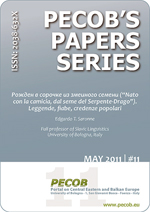and Balkan Europe
by IECOB & AIS Università di Bologna

This area collects and offers a wide range of scientific contributions and provides scholars, researchers and specialists with publishing opportunities for their research results
Slavonic folklore and its influence upon literature. Fairy stories and popular traditions
Рожден в сорочке из змеиного семени (“Nato con la camicia, dal seme del Serpente-Drago”). Leggende, fiabe, credenze popolari
May 2011 | #11
by: Edgardo T. Saronne
Full professor of Slavic Linguistics
University of Bologna, Italy
pp: 40
ISSN: 2038-632X

- May 2011 | #11
Abstract
The paper deals with Slavonic folklore and its influence upon literature. Here the term “folklore" covers oral epics, fairy stories, popular traditions and superstitions; the meaning of "literature" is restricted to XII century chronicles and written epics and also to XV century pseudo-hagiographic compositions. The essay – addressed to non-initiated educated readers – is the result of an original contribution to the meeting "La terra dell'Uccello di fuoco" (Fire-bird Land) held in Bolzano (Italy) in May 2004.
The author shows that neither official annalistic prose – written by monks – nor cultivated epics composed in Christian times are free from reference to myths and beliefs which go back to Slavonic pagan culture – such culture being prior to the X century and perhaps even very ancient and universal. The author proceeds by examining some characteristic features found in the "byliny" (popular epics), which had been transmitted orally for centuries and were transcribed only recently, mainly in the XIX and XX century. The hero, the so-called "bogatyr'", is shown to pursue his own formation also through magic, with the purpose of acquiring skills that remind of shamanism as is still practiced in some parts of Asian Russia. Such skills are supposed to help the hero in the fight against the snake-dragon, that is the old and "false" faith against established Christianity. Sometimes the snake-dragon (which has come to stand for the evil) is viewed as the hero's father, possibly in the sense that the hero himself was born as a pagan; at (?) other times, it is embodied as woman, the hero's temptress and lover. In any case, the snake-dragon is seen as the enemy, the target of the hero's magic skills.
Subsequently, the author surveys some well known fairy tales in the Russian and Slavonic areas. Here the same features concerning magic and the dragon reappear, but without the historical connotations that permeate popular epics. This is to be explained by the fact that fairy stories ("skazki" in Russian) probably go back to far prehistory, perhaps even to an era when humanity was confined to very few groups of people or tribes. This would also explains why the same narrative themes are spread throughout the world.
In the next section, the author examines the reference to magics and to the snake-dragon functioning as metaphors in "The Tale of Petr and Fevronija", a hybrid hagiographic composition which was very popular in the XV century. The text, in spite of its reference to magic, survived because of its popularity and its declared pious purpose, while the dominant pagan orientation of "The Igor's Tale" (Slovo o polku Igoreve) was the cause of its almost total destruction.
Finally, the author considers how several of the themes found in the examined material are also recurring in popular beliefs and superstitions.
Keywords
folklore, oral epics, fairy stories, magic, snake-dragon, shamanism, popular beliefs, superstitions
Table of contents
Abstract
Keywords
1 Premessa
2 Nota introduttiva
3 Le cronache
4 L'epica colta
5 L'epica popolare
5.1 Nascita del bogatyr'
5.2 L'apprendistato
5.3 L'eroe benefico
5.4 L'eroe alla conquista del potere
5.5 Il trionfo finale
5.6 Referenti storici alternativi
5.7 Il drago antagonista
5.8 La donna-serpente
6 Le fiabe
6.1 I temi
6.2 «Il mago e il suo discepolo» (Polonia-Belorussia e Russia – Afanas'ev № 249-253)
6.3 «Il principe Ivan, l'uccello di fuoco e il lupo grigio» (Russia – Afanas'ev № 168)
6.4 «L'acqua viva» (Boemia, Russia – Afanas'ev № 171-178)
6.5 «Non-lo-so» (Russia – Afanas'ev № 295-296)
6.6 «Vasilisa la bella» (Russia – Afanas'ev № 104)
7 Il genere ibrido: la «Povĕst' o Petre i Fevronii»
7.1 I parte: il drago tentatore ucciso dall'eroe, che però viene infettato dal suo sangue.
7.2 II parte: un'astuta eroina, dotata di poteri magici, prende il posto dell'eroe, che diventa temporaneamente suo antagonista e propaggine del drago
7.3 III parte: l'eroina, rifiutata dalla corte principesca per la sua umile origine, trionfa nuovamente grazie alla propria umiltà, astuzia e poteri sovrannaturali
8 La tradizione popolare: superstizioni, incantamenti, esorcismi
8.1 Il serpente di fuoco
8.2 L'incantesimo sul serpente; il serpente in generale
9 Conclusione
Bibliografia
Download the paper
Version
Ver.: 01
Time stamp: 20110525100738


 Download the full paper!
Download the full paper!





